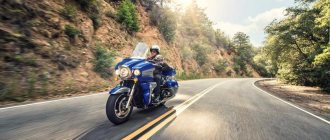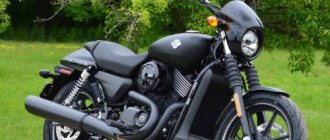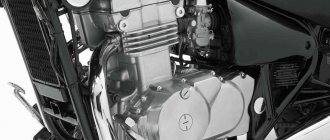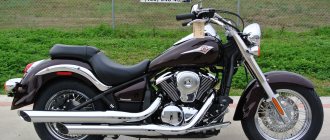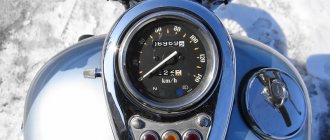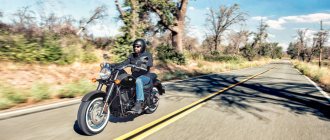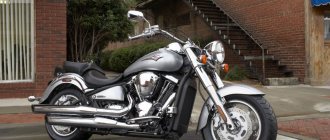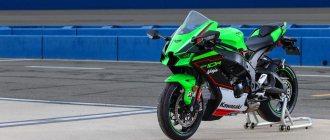Cruiser Kawasaki Vulcan 1700 Voyager 2019
The Kawasaki Vulcan 1700 is a whole line of cruisers, which includes, in particular, a bagger and a full dresser.
*The last term has not yet been established in the Russian language, so we will briefly explain its essence. Dresser in English is a wardrobe or chest of drawers with several drawers, and in the case of motorcycles, this apt term means a device with a standard set of wardrobe trunks, sometimes even non-removable. Unlike a dresser, a bagger is a device with standard side cases, devoid of a central one, and often has a more urban orientation than tourism-oriented dressers. It is characterized by more rapid contours, low comfort of the passenger seat or its complete absence, and the bagger can also be more “undressed”, deprived of part of the hood, if its “dressed” version - the dresser - has one.
Both cruisers are equipped with ABS, have a 1700 cc V-twin engine with liquid cooling and a six-speed transmission. Ready to zip around town or hit the highway, the 1700 Vulcans are quality, reliable motorcycles.
Cruiser Kawasaki Vulcan 1700
Cruiser Kawasaki Vulcan 1700 Vaquero
Kawasaki's Vulcan 1700 line of cruisers was launched in 2009, replacing the existing 1600cc line and continuing the Vulcan series that began in 1984. In terms of design, they are good old classics with retro elements. For example, the dashboard, made in body color, mainly consists of dial gauges - fuel level, speedometer, tachometer and engine temperature indicator, which are easier to read than a digital instrument panel in any lighting conditions. However, modern technologies also have a place here in the form of an LCD display and an on-board information and acoustic multimedia system capable of connecting to a smartphone via Bluetooth, playing music, and displaying motorcycle operating parameters. The system also includes a radio that is compatible with SiriusXM satellite radio. Another interesting feature is the automatic volume level adjustment depending on the speed, adding sound at high speeds and muting the music when stopping.
As befits cruisers, Vulcans have an excellent luggage system. In the case of the Vaquero, these are side cases, and the Voyager also has a central case that can accommodate two integrals. In addition, they have small lockable glove compartments under the speakers where you can put small items that you need for quick access.
MY MOTORCYCLE
Look at these two handsome guys. Motorcycles simply attract the eye with their design and grandeur. You can’t resist them - you just want to sit down and move somewhere far away, admire the landscapes of our planet. But which option to choose: both motorcycles were developed to meet the needs of American riders. Although, if you wish, you can take these “elephants” for a walk along winding roads, if your experience is enough not to put more than 400 kg of bike into the next turn and choose what you prefer. So, on the one hand, Electra Glide Ultra Limited , a motorcycle touring icon and the top of the Harley-Davidson . On the other hand, Japan’s answer to the “American dream” Kawasaki VN1700 Voyager , equipped with a 1700 cc engine, crowns the line of cruisers: the Japanese motorcycle giant. The motorcycle is also available in simpler Classic and Classic Tourer versions with side panniers and a removable windshield. Both heavyweights embody everything you could want for comfortable touring with luggage and a passenger.
The Ultra Limited version is nothing new in the Harley-Davidson line. In fact, we are talking about the next evolution of the Electra Glide, which, having debuted in 1965, offers exceptional comfort to the rider and passenger. The Ultra Limited has all the options of the sophisticated Ultra Classic: internal bags for panniers, a huge top case with new “internals”, a 12-volt outlet and a chrome design on the lid for attaching additional luggage. There are also heated grips and ABS brakes. A special color complements the picture.
Direct competitors of the Electric Train always run the risk of being accused of plagiarism, including the majestic VN1700. Like all “Japanese”, he is trying to snatch market share from the American motorcycle due to technology. A detailed description of the dashboard, due to the dozen buttons scattered on it, would take at least half a page of this article. It should be noted that Kawasaki's button layout is more systematic than Harley's. In some aspects, the “Japanese” play the role of traditional catch-up, while in others the “Americans” have to catch up. Sometimes competitors force a leader to take new steps.
1. Classic Harley two-cylinder Twin Cam with 45° cylinder camber and air cooling. Mounted on silent blocks that dampen vibrations. Starting this year, all Electric Trains are equipped with a 1690 cc engine instead of a 1584 cc engine. This provides an 11% increase in torque2. Fully analog instrument panel with six round indicators. There is a voltmeter, oil pressure gauge and thermometer (in Fahrenheit). The radio is installed in the center, below it is a row of buttons (additional light, cruise control). It would be more logical to install them on the steering wheel so that they are at hand 3. The quality of the buttons on the steering wheel is impeccable, the ergonomics are confusing 4. The braking system consists of three 300 mm discs and 4-grub Brembo calipers on each. ABS is installed stock.
1. Formally, Kawasaki complied with the laws of the class by installing a 1700 cc axle with a 50° cylinder camber and two balancer shafts on the Voyager. Don’t be fooled by the chrome fins on the cylinders: liquid cooling 2. The dashboard layout inherits the style of American muscle cars of the 1960s. True, they did not have a multifunctional LCD display with a lot of useful information. The buttons on the steering wheel are simple, like on the budget 600. There are no complaints about their location. Cruise control is also located on the steering wheel 4. To stop a heavy cruiser, three 300 mm discs with 4-piston (front) and 2-piston (rear) calipers are used. The stock system is equipped with an effective brake force distribution system K-AST and ABS
The riding position on both motorcycles is extremely comfortable and natural. It feels like you are sitting in an easy chair at home. The arms and legs are bent at the correct angle, the feet are given complete freedom of movement on large “ski” footrests. The left leg is slightly limited in free space due to the gear shift lever. Both Harley and Kawasaki have this retro mechanism. It's charming to look at, but not to use. To change gear with your heel, you need to lift your foot off the footrest. However, nothing prevents you from clicking the box in the usual way.
1. Stitched lining on the side fairings are attached with regular buttons, like jacket pockets. Behind them are two hidden glove compartments for small items 2. The new Tour-Pak center case with the ability to secure luggage is simply bottomless. It can hold two integrals or all the necessary things for a weekend for two. There is even a 12-volt socket. The strangely shaped side cases are not convenient to use, but they are equipped with an internal fabric bag 4. “Ski” footpegs with rubber pads successfully dampen vibrations, the gear shift lever (double-sided) can be adjusted 5. Convenient and soft rider seat with a hole for water to drain when riding in the rain 6. Unlike Kawasaki, Harley has a keyless ignition system.
1. On the side fairings in the knee area there are two spacious glove compartments. They can only be locked with a key, so in order to get the necessary thing, you need to stop the motorcycle and “fight” with the locks. Under the right glove compartment there is a 12-volt connector, on the left there is a button for turning on the additional light. The 2.50-liter topcase is less spacious than Harley's. You can only put two half-face cases in it 3. Kawasaki wins back on the side cases, which are large and convenient for use. Their shape is correct, and the lock is easier to open 4. The “ski” footpegs are equipped with rubber pads that dampen vibrations. The rocker-style gearshift lever is not adjustable, but is well positioned 5. The seat looks like a chair in a director's office 6. Unlike Harley, Voyager is equipped with adjustable brake and clutch levers
The engines of the Ultra Limited and Voyager cubic cylinders sound differently: “American” is deep and booming, “Japanese” is somewhat muffled. The Harley engine vibrates noticeably, especially when static. The silent blocks on which the power unit is mounted do everything they can, but they are not omnipotent. Kawasaki's two balancer shafts do a better job. The fact is that some Harley-Davidson clients choose this brand precisely because of such annoying vibrations. They say they convey the spirit of a real American motorcycle. Both cruisers are extremely awkward to park. They are difficult to move back and forth without the help of a motor and are difficult to simply keep balanced at low speeds. The engineers of both companies know this, so they made the seat height as low as possible so that it was always possible to insure maneuvers with your feet. In any case, it’s better not to get caught in traffic jams while driving the Ultra Limited and Voyager.
And not only because of the heavy weight. After a few minutes of driving slowly in traffic (which happened several times during the test drive), the heat coming from the engines became unbearable. In terms of heat level, the leader is the Ultra Limited, which on the right emits deadly heat directly at the feet of the rider and passenger. The good thing is that both bikes have adjustable air vents in the ankle area.
Getting off the road is more comfortable behind the wheel of a Kawasaki, thanks to a convenient hydraulic clutch. At the same time, this makes the motorcycle somewhat slow at the start: Harley starts moving more sharply, like a man. At the same time, the American’s clutch remains quite informative. Mechanical engine noise is not typical for these vehicles. But Kawasaki has a slight advantage: the Japanese engine is almost silent. The gearbox is another matter: the transmission rings and clacks on both motorcycles. It’s good that the belt drive doesn’t make unnecessary sounds. Aerodynamics The aerodynamic protection of motorcycles of this class is excellent by default. But with some reservations. The Ultra Limited leaves only the knees uncovered; the top edge of the windshield is at eye level for an average height rider. It would be better to install the wind deflector lower. Voyaging on Voyager is like driving a car. The large fairing completely protects the rider, and the windshield hardly distorts the view. Such an impressive Kawasaki front fairing exposes some design flaws. When driving Voyager, crackling noises are heard in the area of the dashboard, which indicates poor plastic fastening. Points in the “Build Quality” category go to the opponent. The weight and size of motorcycles can confuse a rider unaccustomed to such machines. But the ease of handling demonstrated by both flagships of the cruiser fleet exceeds all expectations. Naturally, when managing them, you should remain calm. There's no need to rev the motors, both have enough torque to propel the bikes at low revs. Despite the fact that the dynamic performance characteristics of the motorcycles are similar, the Ultra Limited showed itself to be more ready for aggressive acceleration, even in sixth gear.
The Kawasaki, in turn, is lazy in revving and is not suitable for high-gear driving slower than 90 km/h, except on the autobahn. Overtaking is also difficult for him. You can twist the throttle as much as you like, expecting a decent response from the engine, but in response, vibrations only increase, which is not characteristic of the image of a relaxed tourist. Even when resetting the gear down, the result leaves much to be desired.
RADIO: EQUAL PLAY The sound quality of the Harman-Kardon stereo system on the Ultra Limited is better than the Kawasaki systems. Harley also benefits from additional speakers for the “second number” (standard equipment), which our passengers liked, and the ability to install an intercom. The same accessories are available for Voyager, but for additional money: speakers - 381 euros, intercom - 180 euros. Compatibility with external sound sources is better with the “Japanese”, which has a connecting cable in the left glove compartment as standard. For 56 euros, an adapter with a 3.5 mm plug for connecting an MP3 player is available. For 129 euros, a special adapter for iPod is available, which allows you to switch tracks using the buttons on the steering wheel. The ergonomics of the stereo controls give Kawasaki extra points in the fight against Harley: all the keys are grouped on the left handlebar grip and placed at thumb level. On the “American” they are scattered between the two steering handles and the dashboard. When driving at speeds up to 90 km/h, you can enjoy music on both motorcycles. The 80 watts of the Harley system gives a cleaner sound. At high speed, the situation changes: thanks to the Kawasaki's better aerodynamic protection, an “air dome” is created that cuts out the noise of the oncoming flow, leaving the rider alone with the music.
The Ultra Limited is built on the rigid frame introduced two years ago on the Touring line models. Other chassis features unique to this bike include new alloy wheels shod with two-component Dunlop Multi-Tread tires. Kawasaki inherited the frame from the VN2000 cruiser, which was completely redesigned to match the new characteristics of the motorcycle. The results are more than convincing in both cases. The only remark concerns the height of the footpegs on the Voyager: active riding on it quickly ends with the “skis” scraping against the asphalt.
PASSENGER: “JAPANESE” IS MORE COMFORTABLE Passengers who have been “run in” for many thousands of kilometers were invited for a test drive. They liked the position of the number two seat on both motorcycles. Kawasaki has it installed higher, and the backrest is moved back a little further. The back of a Harley chair hugs the body better. Both bikes provide plenty of legroom. The spacious footrests are located so that the passenger is comfortable and are equipped with rubber pads. It is noteworthy that the Electra Glide engine transmits more vibrations to them than the Voyager engine. The really noticeable flaw of the Harley, which allows the Kawasaki to come out ahead in terms of passenger comfort, is the hot air from the right exhaust duct, which warms the legs.
Both cruisers are, first and foremost, comfortable motorcycles, so there is no point in judging their suspensions using criteria that apply to bikes of other genres. Voyager is allowed to rock on uneven surfaces, like a yacht on the waves of the ocean. There is nothing you can do about it: the only adjustment available is the preload of the rear shock absorbers.
In the case of the Ultra Limited, you need to keep the pressure of the air rear shock absorbers under control. With the price of the motorcycle, it would be possible to give buyers a branded small pressure gauge, rather than offer it as an option at an additional cost. The fork holds up well even during vigorous riding. Like Kawasaki, this is a conventional telescopic design, without adjustments.
The Brembo brakes installed on Harley are effective and powerful, and the front calipers are also quite informative. But in order to confidently slow down on the American, you need to make serious efforts on the lever. Kawasaki is ready to stop in any conditions thanks to the K-AST system (Kawasaki Advanced Coactivebraking Technology). Braking, provided by three 300 mm discs, is distributed between the front and rear axles by an electronic control unit that “reads” the pilot’s command, even if it only acts on the front brake lever or the rear brake pedal. The result is braking action that is balanced between the two axles, without fork sag. Definitely, the Japanese do not plan to overtake Harley in terms of acceleration dynamics, but they offer the rider more peace of mind and confidence in difficult situations. And rightly so: such motorcycles are not bought for the sake of risk and adrenaline.
Source: Bike magazine
Full cruise control
The devices have a convenient cruise control setting, performed on the right remote control, and this is not just a lock of the throttle, but full-fledged cruise control. The speed can be set in the range from 48 to 136 km/h, it can be changed on the go, and the device will maintain it even on ups and downs.
Brief history of the model
2009 - start of production and sales of the Kawasaki VN 1700 Vulcan model series. Model: Kawasaki Vulcan 1700 Classic; Kawasaki Vulcan 1700 Classic Tourer (Nomad); Kawasaki Vulcan 1700 Classic LT; Kawasaki Vulcan 1700 Voyager / ABS (North America, Europe, Australia). Factory designation: VN1700E9F; VN1700C9F; VN1700G9F; VN1700A9F, VN1700B9F (ABS).
2010 - no significant changes. Model: Kawasaki Vulcan 1700 Classic / ABS; Kawasaki Vulcan 1700 Classic Tourer ABS (Nomad); Kawasaki Vulcan 1700 Classic LT; Kawasaki Vulcan 1700 Voyager / ABS (North America, Europe, Australia). Factory designation: VN1700FAF, VN1700EAF; VN1700DAF, VN1700CAF; VN1700GAF; VN1700AAF, VN1700BAF (ABS).
2011 - appearance of the Kawasaki VN1700 Vulcan Vaquero modification. The Classic LT modification is no longer offered. Model: Kawasaki Vulcan 1700 Classic / ABS; Kawasaki Vulcan 1700 Classic Tourer ABS (Nomad); Kawasaki Vulcan 1700 Voyager / ABS; Kawasaki Vulcan 1700 Vaquero (Voyager Custom) / ABS (North America, Europe, Australia). Factory designation: VN1700FBF, VN1700EBF; VN1700DBF, VN1700CBF; VN1700ABF, VN1700BBF (ABS); VN1700JBF, VN1700KBF.
2012 - no significant changes. Model: Kawasaki Vulcan 1700 Classic / ABS; Kawasaki Vulcan 1700 Classic Tourer ABS (Nomad); Kawasaki Vulcan 1700 Voyager / ABS; Kawasaki Vulcan 1700 Vaquero (Voyager Custom) / ABS (North America, Europe, Australia). Factory designation: VN1700FCF, VN1700ECF; VN1700DCF, VN1700CCF; VN1700ACF, VN1700BCF (ABS); VN1700JCF, VN1700KCF.
2013 - no significant changes. Model: Kawasaki Vulcan 1700 Classic / ABS; Kawasaki Vulcan 1700 Classic Tourer ABS (Nomad); Kawasaki Vulcan 1700 Voyager / ABS; Kawasaki Vulcan 1700 Vaquero (Voyager Custom) / ABS (North America, Europe, Australia). Factory designation: VN1700FDF, VN1700EDF; VN1700DDF, VN1700CDF; VN1700ADF, VN1700BDF (ABS); VN1700JDF, VN1700KDF.
2014 - no significant changes. Model: Kawasaki Vulcan 1700 Classic ABS; Kawasaki Vulcan 1700 Classic Tourer ABS (Nomad ABS); Kawasaki Vulcan 1700 Voyager / ABS; Kawasaki Vulcan 1700 Vaquero ABS (Voyager Custom ABS) (North America, Europe, Australia). Factory designation: VN1700FEF; VN1700DEF; VN1700AEF, VN1700BEF (ABS); VN1700KEF.
2015 - Classic modification is no longer offered. Model: Kawasaki Vulcan 1700 Classic Tourer ABS (Nomad ABS); Kawasaki Vulcan 1700 Voyager ABS; Kawasaki Vulcan 1700 Vaquero ABS (Voyager Custom ABS) (North America, Europe, Australia). Factory designation: VN1700DFF; VN1700BEF; VN1700KFF.
2016 - no significant changes. Last year of production and sales in Europe. Model: Kawasaki Vulcan 1700 Classic Tourer ABS (Nomad ABS); Kawasaki Vulcan 1700 Voyager ABS; Kawasaki Vulcan 1700 Vaquero ABS (Voyager Custom ABS) (North America, Europe, Australia). Factory designation: VN1700DGF; VN1700BGF; VN1700KGF.
2017 - The Classic Tourer (Nomad) modification is no longer offered. Model: Kawasaki Vulcan 1700 Voyager ABS; Kawasaki Vulcan 1700 Vaquero ABS (Voyager Custom ABS) (North America, Australia). Factory designation: VN1700BHF; VN1700KHF.
2018 - no significant changes. Model: Kawasaki Vulcan 1700 Voyager ABS; Kawasaki Vulcan 1700 Vaquero ABS (Voyager Custom ABS) (North America, Australia). Factory designation: VN1700BJF; VN1700KJF.
2019 - no significant changes. Model: Kawasaki Vulcan 1700 Voyager ABS; Kawasaki Vulcan 1700 Vaquero ABS (Voyager Custom ABS) (North America). Factory designation: VN1700BKF; VN1700KKF.
2020 - no significant changes. Model: Kawasaki Vulcan 1700 Voyager ABS; Kawasaki Vulcan 1700 Vaquero ABS (Voyager Custom ABS) (North America). Factory designation: VN1700BLF; VN1700KLF.
2021 - no significant changes. Model: Kawasaki Vulcan 1700 Voyager ABS; Kawasaki Vulcan 1700 Vaquero ABS (Voyager Custom ABS) (North America). Factory designation: VN1700BMFNN; VN1700KMFAL.
Chassis
Judging by the weight of almost 400 kg, the manufacturer abandoned the idea of making it light and instead made it strong. The duplex steel tubular frame with square profile main beam has obvious advantages over the aluminum frame. The wheels are 16 inches in size, the steering angle is 30 degrees, and the trail is 178 mm, which with a wheelbase of 167 mm gives excellent stability on straight lines even in crosswinds, and therefore the motorcycle resists slightly in turns, but for this class of technology this is completely natural. The total length of the bike is just over 2.5 meters, but long does not always mean tall, and the 72 cm high seat is proof of this: it will be comfortable for a rider of almost any height.
The front suspension has 14 cm of travel, and the rear gas shock absorbers give 7.8 cm of travel - you can't call it a lot of travel. However, thanks to the ability to pump gas, the rear suspension has a very soft ride, and with four stages of rebound adjustment, it is suitable for different loads and different conditions. Two four-piston front calipers and a two-piston rear caliper are mounted on 300mm discs, both equipped with a proprietary ABS system called Kawasaki Advanced Coactive-braking Technology K-ACT II.
Engine
Kawasaki builds a line of big Vulcans to suit the tastes of the American consumer: it's a cruiser, it's a V-twin, and it's as many cubic inches as possible. The engine in this line is 1700 cubic centimeters or 103.7 cubic inches, and this is one of the largest V-twins in the world. And even despite the heavy weight of the devices, these are some of the most high-torque motorcycles with their 146 Nm of torque . The water-cooled engine has a 52-degree cylinder angle and is ideal for cruisers. The cylinders have a diameter of 102mm and a piston stroke of 104mm, giving it a slightly long-stroke character, while the 9.5:1 compression ratio allows it to run on relatively inexpensive grades of petrol. The engine breathes through two throttle bodies with a diameter of 42 mm. Power is transmitted from a six-speed high-ratio transmission to the rear wheel via a carbon fiber-reinforced belt.
So, this car is too heavy for drag racing, but it is great for touring, especially on the highway, where thanks to two high-speed top gears, the car rides well at low revs, while having a large reserve of torque for rapid overtaking.
